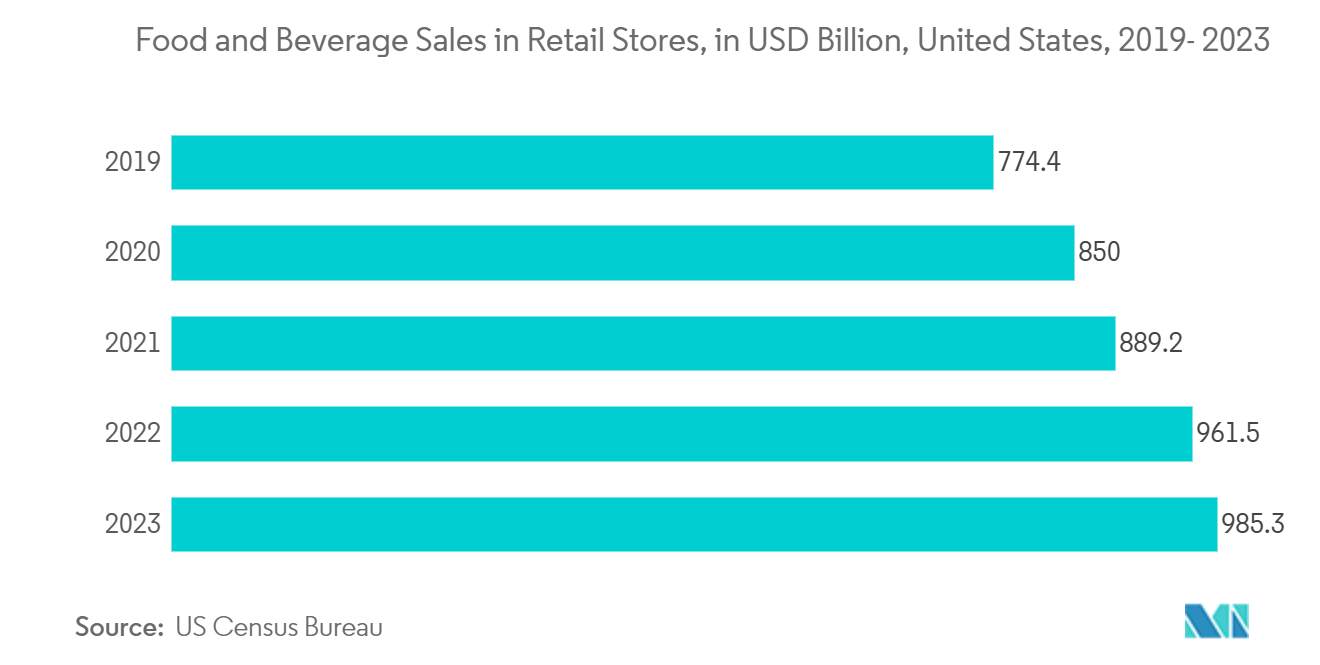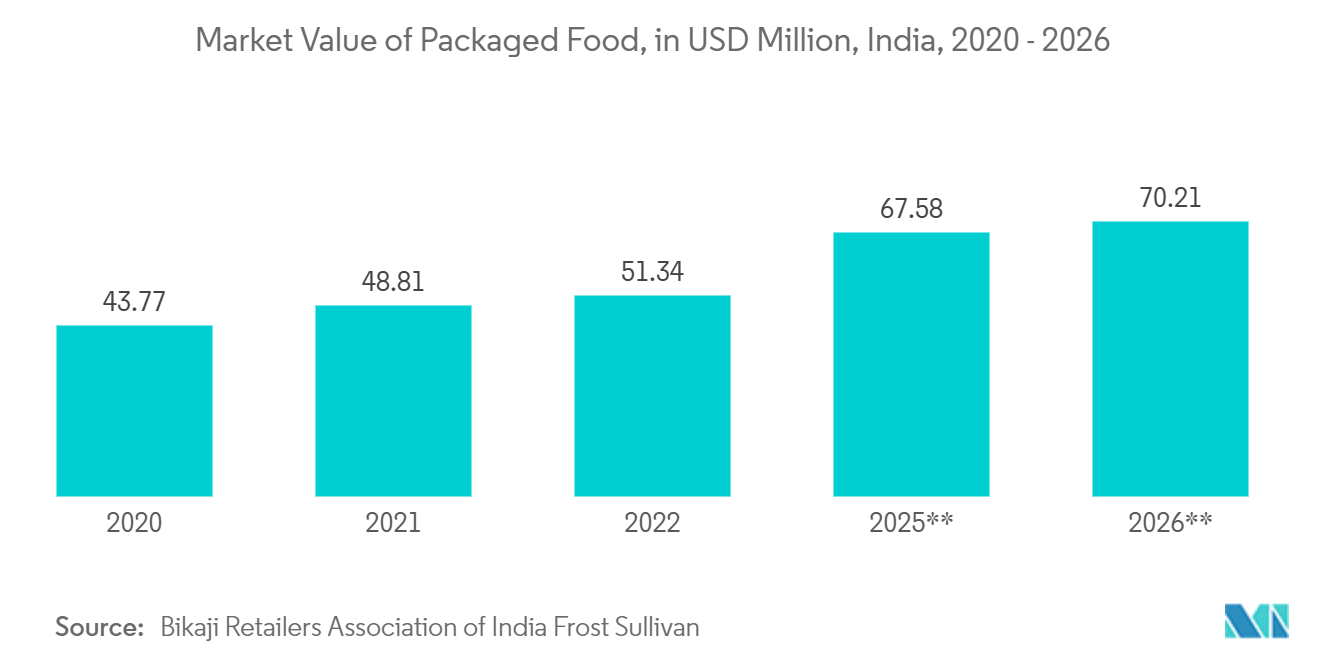Market Trends of Packaging Printing Industry
Food and Beverage Sector is Expected to Hold Significant Market Share
- The packaging industry has undergone substantial changes in recent years, driven by the global increase in food and beverage consumption. This evolution is closely tied to shifting consumer preferences, technological progress, and growing sustainability concerns. Consumers increasingly demand convenient, eco-friendly packaging solutions that preserve food quality and extend shelf life. Simultaneously, advancements in printing technologies have enabled more sophisticated and eye-catching designs on packaging materials.
- In the United States, annual retail food and drink sales have risen significantly, mirroring global trends. Sales reached USD 850 billion in 2020 and increased to USD 985.30 billion in 2023. This growth reflects not only population increases but also changes in eating habits, with a rise in packaged and convenience foods. The expansion of e-commerce and food delivery services has further fueled the demand for innovative packaging solutions.
- This growth in the food and beverage sector has created a demand for diverse printing formats in packaging, particularly within the industry. Digital printing, for instance, has gained popularity due to its ability to produce high-quality, customized packaging in smaller quantities. Flexographic printing remains a staple for large-scale production, while gravure printing is favored for premium packaging with intricate designs. The industry also explores sustainable printing options, such as water-based and UV-curable inks to align with environmental concerns.
- The increasing demand for food and beverage products is expected to drive growth in the food and beverage printing market. As consumers seek more diverse and visually appealing products, companies in this sector are increasingly utilizing innovative packaging and printing solutions to differentiate their offerings and enhance shelf appeal. In response, the printing industry within the food and beverage sector is adapting to meet these evolving needs by incorporating new technologies and sustainable practices in packaging printing, aligning with market demands.
- The growing variety of food and non-food products and increased demand for food and beverages has led to a significant trend in quality printing for packaging. This trend is driven by the need for labels and packaging that can withstand extreme conditions, such as freezing temperatures, and maintain durability. Water-resistant printing for labels has become essential, particularly for products like bottled beverages that may be exposed to moisture or ice.
- The demand for printing in food packaging is increasing due to rising consumer preferences for packaged products. This trend is driven by changing eating habits and evolving lifestyles, which may significantly impact the market. The growth in per capita disposable income and expanding population are expected to boost product demand, owing to the high barrier properties, extended shelf life, and consumer safety offered by printed packaging. Printing on food packaging materials serves both informational and marketing purposes. Various packaging materials, including plastics, paper, cardboard, and cork, can be directly printed.
- The food packaging industry is evolving to meet consumer demands for transparency and quality. Nutritional information printed on packaging enhances awareness, while the trend toward natural, minimally processed foods drives innovation in packaging design. Food packaging serves multiple purposes, including protection, convenience, and portion control. Sustainable packaging solutions address food waste and safety concerns.
- Regulatory bodies mandate detailed labeling, emphasizing the importance of high-quality printing. For instance, the Food Safety and Standards Authority of India (FSSAI) requires comprehensive information on food pouches. Manufacturers prioritize strict controls to protect consumers, adhering to comprehensive legislation governing all aspects of food packaging, including labels. This focus on transparency, quality, and safety in food packaging reflects the industry's response to changing consumer preferences and regulatory requirements.

Asia is Expected to be the Fastest-growing Market
- The packaging printing market in Asia is substantial, incorporating various printing technologies and applications across multiple industries. Countries like China, India, Japan, and South Korea have experienced significant demand for packaging solutions. Multiple sectors drive this demand, including food and beverages, consumer electronics, and other industries.
- In China, the rapid growth of e-commerce has fueled the need for innovative packaging solutions, particularly in corrugated boxes and flexible packaging. India's burgeoning middle class and increasing urbanization have led to a surge in packaged food and personal care products, boosting the packaging printing sector. Japan, known for its advanced technology, continues to lead in high-quality packaging printing for premium products and electronics. South Korea's robust electronics industry drives demand for specialized packaging printing services.
- The region has also shifted toward sustainable packaging solutions, with many companies adopting eco-friendly materials and printing processes. This trend is particularly evident in Singapore and Taiwan, where environmental concerns increasingly influence consumer choices and corporate policies.
- Multiple factors drive this demand. Rapid urbanization and evolving consumer lifestyles have increased the need for packaged goods. The expanding middle-class population in these countries has contributed to higher consumption of packaged products. Furthermore, the growth of e-commerce in the region has accelerated the demand for innovative and sustainable packaging solutions.
- The packaging printing market in the region is aligning with global trends, notably in sustainable and intelligent packaging technologies. Key initiatives include adopting biodegradable materials, a concerted effort to reduce plastic usage, and integrating QR codes and RFID tags to enhance traceability and boost consumer engagement. Additionally, companies are investing in advanced printing techniques to improve packaging quality and efficiency, and there is a growing focus on using eco-friendly inks and coatings.
- Packaging printing is pivotal in India across multiple sectors, including food and beverage, pharmaceuticals, cosmetics, electronics, and the automobile industry. Notably, the food and beverage sector has seen a surge in adopting digital data printing on packages. This trend is primarily driven by the need to communicate essential details like shelf-life, ingredients, and nutritional information. Reflecting this growth, the market value of packaged food in India jumped from USD 43.77 million in 2020 and is projected to reach USD 70.21 million by 2026. Such robust expansion in the packed food market is fueling rising demand for varied printing techniques in packaging.
- Rising consumer spending and demand for durable goods drive packaging advancements in Asia. They increased processed food consumption and emerging packaging printing technologies further fuel market growth. The pharmaceutical sector and demand for convenient packaging also contribute significantly. The rise in demand for standard products in Asia boosts small and medium-scale industries, enhancing the digital printing packaging market.
- Investments in packaging industry R&D drive global market expansion and printer innovation. In February 2024, Canon introduced three new images PROGRAF GP Series printers (GP-526S/546S/566S) for the Asia-Pacific market, packaged in eco-friendly cardboard boxes. The GP546S model reduced polystyrene foam packaging by 89.5%, minimizing waste and promoting environmental sustainability.


